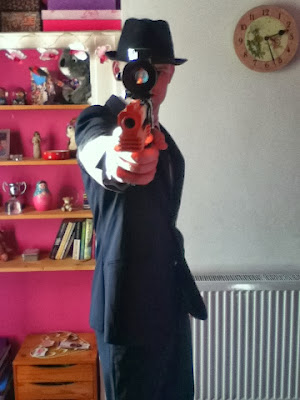During the first edit of our final footage we noticed some issues with our mise en scene and steadiness of our shots.
Modern Plug Socket
The first issue we found was with the mise en scene used for the dark room scene, as our film is set in the 1940/50s, yet a modern plug socket takes up most of a shot. This modern object is very noticeable in the shot due to the high contrast of the white plug socket against the shadowy room; which draws attention away from the developing tank which we are filming to a flaw in our mise en scene, making the shot less relevant and authentic to its era. We have discussed this problem with our teacher and have decided to reshoot this scene.

Screenshot of plug socket in scene

I researched 1940/50s plug sockets which were appropriate for our era
Whiteboard
In another shot within the dark room scene, the large dry erase whiteboard in the dark room is visible. I researched when dry erase whiteboards were introduced to the UK to see if it was within the era our opening sequence is set, but found that
it dates to the late 1950s and early 1960s. As our opening sequence is set between 1940/ early 1950s, to include the whiteboard would make our mise en scene inaccurate.
Modern Car
Another recognised continuity error was a modern car passing in the background of a shot from the Pecc Street scene. As the car is so modern, it would not be seen during the 1940/50s, and therefore must not be in our opening sequence. However, a re-shoot was not required for this error, as I filmed multiple takes of this shot, which I have replaced this with. Because Morrighan and I liked the acting and camera angle for this particular shot, I also cut and cropped out the car continuity error, so that the footage could still be used for our opening sequence.

Screenshot of car in the background of Pecc Street scene
Instruction Posters
We noticed that the very visible A4 posters with instructions for the students who use the school dark room to follow were unrealistic for this scene. Although they are not unsuitable for the 1940/50s, we decided that a journalist who captures and develops photographs for an occupation would not need instructions to remind him how to do his job; therefore making the posters unnecessary and creating discontinuity for the mise en scene against the narrative. This is just one of the factors that have encouraged our decision to re-shoot the dark room scene.
As we have noticed so many important continuity errors with mise en scene, we feel that a re-shoot to amend them is definitely required, as our current footage for this scene is not at all accurate enough with our mise en scene. For our re-shoot of this scene, we will be filming in a new location - the photography studio. We have chosen this location because:
- There are no windows, making is a suitable dark room
- 3 of the walls are completely clear and free from mise en scene interference
- There is special artificial lighting equipment and available (hidden) plug sockets for if we take the dark room's portable red lights to this room
However there is no table/surface within the room to develop the picture, which means we will need to bring this along, as well as a line and clips to dry the photographs, the wall montage, and all necessary developing equipment to lay on the tables.
Steadiness
Another error that we noticed within the footage was the steadiness of the mid to pan down shot where the anti-hero is looking at the montage. The tripod that we were using from the photography department (where we were filming) did not have a panning lever or very high legs. Therefore to try and keep the camera steady, I held the tripod raised so that it was high enough to film the anti-hero's upper body, and tilted the tripod manually. After watching the footage during our first edit, we found that the pan down is diagonal rather than straight as a result of the difficult tripod we used. This is a different shot from the straight pan down shot which follows it in the next scene. So that these two shots are fluid, we will bring a tripod with a panning lever to the re-shoot; enabling us to achieve a straight and steady pan down shot.


















